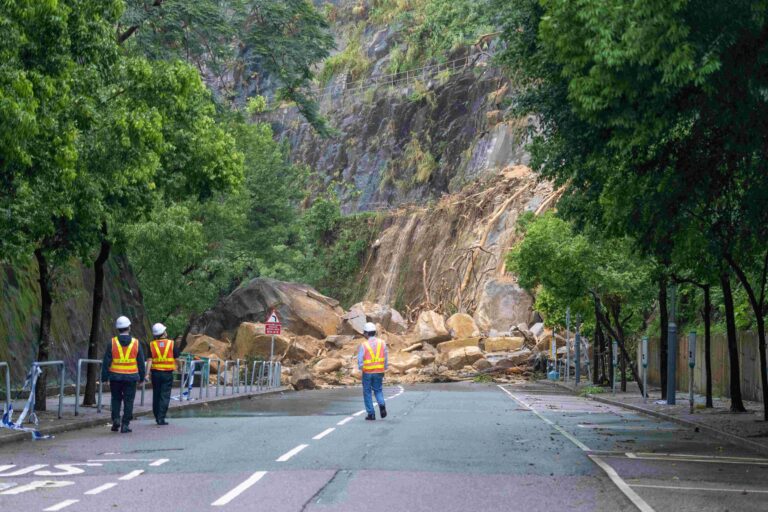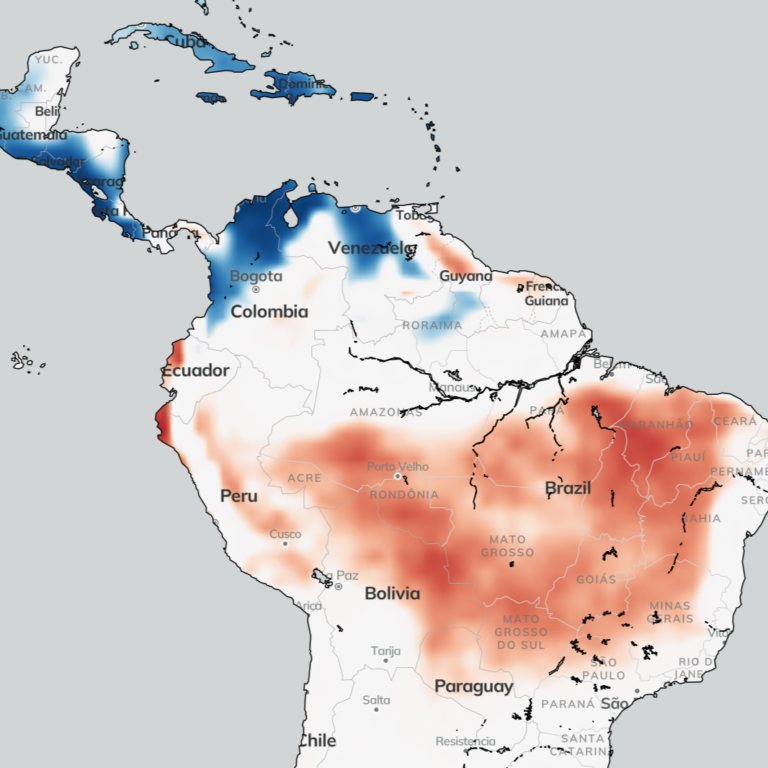Understanding Natural Hazards: Definition, Examples, and Future Perspectives
Natural disasters are occurring more frequently, and their severity is increasing. In light of this alarming development, it is key to understand the causes and implications of the various types of natural hazards, in order to better assess the physical climate risks that emanate from them.
This article provides a definition of natural hazards and explores the different categories of natural hazards that exist. Recent events such as the droughts caused by El Niño in 2024 are analyzed, before moving on to a discussion of the implications that natural hazards can have for businesses across various industries. State-of-the-art and accurate climate risk analytics are key to assess and mitigate the impacts of natural hazards and physical climate risks.
Natural Hazards Definition
Natural hazards are phenomena that can occur within the natural environment and may cause harmful consequences to humans, property damage, environmental degradation, or social and economic disruption.
Natural hazards pertain to phenomena that could cause damage and harm, and it is important to note the distinction between hazards and risks. While a hazard refers to a situation that has the potential to lead to (negative) consequences, risk relates to the likelihood of hazards occurring and the severity of their consequences. In effect, natural phenomena such as hurricanes, heatwaves, or floods are only considered natural hazards if people, ecosystems, infrastructure, resources, or businesses can be affected by them. In turn, the risk associated with these natural hazards expresses the probability and extent of the damages that could arise from these hazards.
Many natural hazard definitions exist, but a key differentiator from other hazards is the respective trigger element. For example, technological or industrial hazards are induced by human activities, while we define natural hazards as hazards that are triggered by natural processes such as geological movements, atmospheric conditions, or oceanographic movements.

Types of Natural Hazards
International institutions like the United Nations Office for Disaster Risk Reduction or the International Federation of Red Cross and Red Crescent Societies differentiate between several types of natural hazards. In general, those can be separated in two distinct categories:
- Climatological hazards include all meteorological and hydrological hazards, as well as any climate-change induced hazard. Among the list are droughts, heat or cold waves, floods, storm surges, tropical cyclones, or blizzards and hailstorms. These climatological hazards are typically triggered by a lack of precipitation, temperature anomalies, global warming, or climatic phenomena. Most of these are often triggered by extreme meteorological conditions such as atmospheric pressure changes and strong winds, and other climatological factors.
- Geological or geophysical hazards, on the other hand, pertain to any internal earth-related processes, which manifest in form of earthquakes, volcanic activity, tsunamis, or landslides/debris flows. These hazards are triggered by various types of acute and chronic changes in the earth’s structure, but also by climatological, hydrometeorological factors.
In some cases, these various types of natural hazards are interrelated. Therefore, they cannot always be observed or analyzed on their own, as the consequences of a specific hazard type might form the causes of another. A good example of this interconnectedness are landslides, a geological hazard type, that can be induced by heavy precipitation events of climatological origins.

Another aspect to note is the importance of anthropogenic global warming, which is an increasingly relevant factor in climatological hazards, creating severe physical climate risks across the world. Human activities are increasing the concentrations of greenhouse gases such as carbon dioxide (CO2), methane, and others, and the effects of a warming atmosphere can lead to more severe and/or more frequent occurrences of extreme events.
Examples of Natural Hazards
In many regions, climate change increases natural catastrophe risks, and recent examples of extreme events whose intensity or increased occurrence rate were are a clear signal of the need for increased preparedness and risk mitigation.
From a climatological perspective, a recent example of a natural phenomenon that can influence natural hazards is the relatively strong El Niño phase in 2023 and 2024. El Niño is a naturally occurring coupled ocean-atmosphere phenomenon that typically occurs every two to seven years and typically lasts 9 to 12 months. It can lead to extreme conditions in certain regions such as droughts, exceptionally high rainfalls, and changes in wind patterns. In recent months, Brazil and other parts of South America have been subject to severe droughts and wildfires in the Amazon Rainforest, mainly due to the lack of rain caused by El Niño. Simultaneously, El Niño tends to favor stronger hurricane activity in the Eastern Pacific with impacts on Central America, essentially accentuating climatological natural hazards. La Niña, on the other hand, is the other phase of the so-called El Niño – Southern Oscillation (ENSO) pattern and typically enhances hurricane activity in the Atlantic due to a reduction of vertical wind shear.
Another natural hazard example is the ongoing heavy precipitation and floodings occurring in India and other parts of South Asia, which started early in the Summer this year. Although these floodings and heavy precipitation events are in line with climatic patterns such as the monsoon months, climate change has amplified these climatological hazards. Indeed, according to Roxy Mathew Koll, a climate scientist at the Indian Institute of Tropical Meteorology, extreme rainfall events have tripled in India since 1950. The flooding events across India in 2024 are extreme, with devastating human consequences and disruptions in business operations in various sectors.
Finally, as an example of geological hazard, Turkey and Syria were hit by two consecutive earthquakes of magnitudes 7.8 and 7.5 respectively, in early February of 2023. More than 50’000 people lost their lives, and the cost of direct physical damage was estimated to be over $34 billion. Many buildings collapsed or were heavily damaged, and millions of people were displaced. The geological hazard in this region was known, but no scientific methods are available to accurately predict a major earthquake. Nevertheless, scientists can use risk models to assess the probability that a significant earthquake will occur in a specific area within a certain period. Earthquakes, even though rarer than hydrometeorological events, often tragically demonstrate the sheer force of natural hazards and of the severe consequences that may result.



Quantifying the Probability of Extreme Events
In risk assessments, return periods are often used to express an average recurrence interval between events such as floods, storms, or earthquakes. While return periods are usually expressed in years, they can be interpreted as an annual exceedance probability for an event. For example, a flood level with a 50-year return period has an annual probability of 0.02 or 2% of being exceeded in any given year. Return periods indicate the statistical measure of the average time interval between hazard events. Longer return periods typically suggest lower probabilities that hazards will occur in any single year. To illustrate this, countries in Central America have lower return periods for hurricanes of a given intensity compared to regions further north such as New York, due to their geographical location in the hurricane-prone Caribbean and North Atlantic basins.
Natural Hazard Regulation and Resilience
Across the world, several governments and international institutions have put in place regulations and frameworks to manage and mitigate exposure to natural hazards. Among those is the EU taxonomy, a classification system that enables companies and investors to identify environmentally sustainable economic activities, and provides guidance related to natural hazards.
Under its Do No Significant Harm (DNSH) principle, public and private actors should consider resilience to natural hazards in their economic and development activities. Projects must be designed in a climate-resilient way and must not exacerbate the impacts of natural hazards such as floods, landslides, or wildfires. Moreover, for activities to be considered sustainable under the EU Taxonomy, they need to include a thorough risk assessment of potential natural hazards. This involves identifying exposure and analyzing vulnerability to determine risk and incorporate resilience measures to cope with natural hazard and climate risks.
Natural Hazards Implications across Industries
As discussed in the previous section, natural hazards can have serious impacts on communities, infrastructure, and businesses. Industries of all sorts can be impacted by natural hazards and must closely monitor the weather and physical climate risks that they are exposed to. Common impacts of natural hazards include damage to infrastructure, destruction of resources, supply chain issues and bottlenecks, loss of clients, demand volatility, or employee unavailability.
For example, droughts and floods can impact the farming and agricultural sectors, impacting crops, livestock, or causing damage to machinery and infrastructure. In the case of El Niño, a drought in 2023 caused farmers in Peru’s Central Andes to abandon their dried out land, because of water shortages which reduced pasture for flocks of alpacas to graze, and made it nearly impossible to cultivate crops.

In the chemical and pharmaceutical manufacturing industries, natural hazards such as floods or water shortages can cause damage to materials, products, and machinery, or affect access to water, energy supply, or transport capacity. These damages can in turn lead to heavy supply chain disruptions and financial losses.
As for the logistics and freight industry, climatological and hydrometeorological natural hazards can put significant pressure on global supply chains, important logistic hubs or shipping routes such as the Panama Canal, with impacts on lead times and operations. For example, a drought exacerbated by El Niño in Central America in 2023 led to disruptions in worldwide shipping, as the key global shipping route via the Panama Canal was disrupted because of low water levels.
Climate Risk Analytics for Natural Hazards
The frequency of natural hazards is expected to increase along with global warming. Climate change is anticipated to lead to more frequent and severe extreme weather events, including heatwaves, heavy precipitation, and tropical cyclones. Warmer atmospheric temperatures, heightened by greenhouse gas emissions, will make hurricanes and other natural hazards more intense. The impacts of more frequent natural hazards will also lead to sea level rise, coastal floodings, biodiversity loss, human displacement and migration, and various other consequences.
Against the threats of more frequent and increasingly severe natural hazards, governments, institutions, and the private sector alike are developing innovative solutions in climate preparedness and resilience. The first step in developing effective and strong resilience strategies is the assessment and analysis of climate risks that are material for a certain region, ecosystem, or business activity. Climate risk analytics solutions empower companies and institutions to reduce their exposure to physical climate risks, develop trust among their stakeholders, ensure financial stability by avoiding climate damage costs, and comply with regulatory frameworks on climate risks and natural hazards.
Natural Hazard Resilience with Correntics
Correntics provides state-of-the-art climate risk analytics, natural hazards exposure assessments, and scenario analyses to support companies in their climate resilience strategies. With scientifically robust data and efficient high-quality risk quantification capabilities, the Correntics platform enables its users to analyze and mitigate business interruption risks, identify vulnerable hotspots across operations, and implement adequate and informed decision-making processes.



